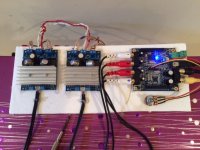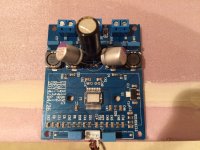I have a couple of questions about switching frequency.
My understanding is that if one goes for a higher switching frequency, we might be able to avoid the peaking in the upper audio frequency range that some of us are having with poorly selected output filter component values (as in thr YJ blue board).
is this assumption right?
Now should this prove to be right, how hard is it to set the AM0 pin to logical level 1 thus get the amp to switch at 1000khz and how would one go about doing it?
One last question, are there any disadvantages to going with a higher switching frequency?
Regards,
Nick
My understanding is that if one goes for a higher switching frequency, we might be able to avoid the peaking in the upper audio frequency range that some of us are having with poorly selected output filter component values (as in thr YJ blue board).
is this assumption right?
Now should this prove to be right, how hard is it to set the AM0 pin to logical level 1 thus get the amp to switch at 1000khz and how would one go about doing it?
One last question, are there any disadvantages to going with a higher switching frequency?
Regards,
Nick
I think YJblue decoupling isn't good enough for 400khz switching. Lowering switching frequency might improve performance.
I think YJblue decoupling isn't good enough for 400khz switching. Lowering switching frequency might improve performance.
400KHz is the lowest selectable frequency.
I just got my TDA7492's today and hooked them up. They sound very nice! Need more time to evaluate but I am quite blown away given the $8 price (as low as $6 depending on seller). Build quality is decent with a massive aluminum heatsink. I will report back later but so far so good. Is there already a TDA7492 thread somewhere?
Wholesale Product Snapshot Product name is TDA7492 D Class High-Power Digital Amplifier Board 2x50W AMP Board with Radiator
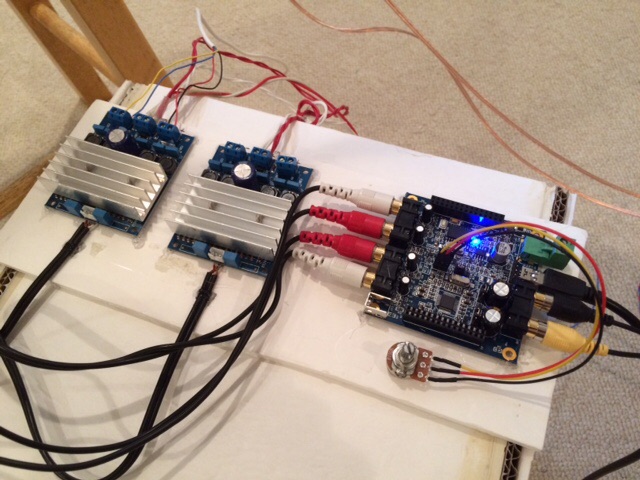
Nice!!!.... I Still have mine in the post...
How does it sound compared to the tpa3116!?...
We might sound open a New thread, so We do not hijack this one... LoL...
I have been searching for hours and hours in this thread, trying to find the best cheap board and I can't get the answer. Which 2.0 cheap board is currently "the best"? YJ 2.0? YJ "audiobah"? Any other? Thanks a lot 🙂
Actually how to select 100khz is known, considering most 2.1 amps have slave running at 100khz and some have main L&R as slave. Between 100khz and 400khz might be a little more work400KHz is the lowest selectable frequency.
Gmarsh's Wiener amp has dip switches for selecting frequency 🙂. Many people thinks that amp sounds best at 4-500kHz. I've tried 1000kHz and the upper treble didn't sound right to me.. Maybe if the choke material were designed for 1000kHz it would sound better? But from what I've read there is some disadvantages too with very high switching frequency. (Like the chip running extra hot). Personally I don't think peaking is a problem in a well designed output filter@500kHz. Cheap chokes and caps plays a far bigger role.. If you wan't good sound at a decent output level get some good chokes!
There is an ongoing thread about TDA7492 and many of them have good sound! My version is the one with round and taller chokes. That version is a good choice if you have low sensitive speakers.
There is an ongoing thread about TDA7492 and many of them have good sound! My version is the one with round and taller chokes. That version is a good choice if you have low sensitive speakers.
Outputinductors filter beyond -40dB for switching frequency if higher frequency is selected, can't be worse.
7492 might be ok with higher impedance speakers, power doesn't make a difference for lower efficiency speakers, distortion might. The 7492 runs much warmer from same PSU voltage and with same speakers and has giga heatsink compared to 3116 which really gets beyond warm with 4 ohm speakers. ST datasheet efficiency seems uncomparable with TI datasheet efficiency and imho real life efficiency.
7492 might be ok with higher impedance speakers, power doesn't make a difference for lower efficiency speakers, distortion might. The 7492 runs much warmer from same PSU voltage and with same speakers and has giga heatsink compared to 3116 which really gets beyond warm with 4 ohm speakers. ST datasheet efficiency seems uncomparable with TI datasheet efficiency and imho real life efficiency.
I seem to remember that the chokes got hotter with the high switching frequency (1000kHz) and doesn't the heat increase the resistance in the chokes? (Most chokes are max current rated). And won't the increased resistance/heat inturn affect the distortion numbers? I mentioned low efficiency speakers since the currents are usally a lot higher at the same spl than high sensitivity speakers. I do belive I've noticed a trend with upgrading the inductors-->the larger ones sounds better than the small/hot ones when I push the amps.. I might be wrong cause the effect isn't huge and probably won't be noticed in many setups.
I completely agree with you Irribeo on the TDA chip generating a lot more heat than the TPA chip.
I completely agree with you Irribeo on the TDA chip generating a lot more heat than the TPA chip.
I haven't noticed warmer inductors with 3116 and 600khz, but when inductors get to chiptemp they likely get warmer indirectly, don't know if that matters much.
7492 uses same powersupply voltages, produces much more heat, yet it is supposed to be more efficient and although maximum current for 7492 also is lower than for 3116 it is supposed to be more powerfull. A collection of remarkable data that seems to be wrong somehow🙂
7492 uses same powersupply voltages, produces much more heat, yet it is supposed to be more efficient and although maximum current for 7492 also is lower than for 3116 it is supposed to be more powerfull. A collection of remarkable data that seems to be wrong somehow🙂
i do not like the input connector of the tda7492 module.
it is not standard 2.54mm spacing.
you can neither replace it with something more common nor put three female dupont wire side by side onto it.
its pin are very short, which is a minus for me.
i've noticed the inductors getting warm, too.
mine played for about 10 hours nonstop, got warm, but not too warm.
the black tda7498 (~11€ shipped) is still my favorite for 8Ohm speakers.
it is not standard 2.54mm spacing.
you can neither replace it with something more common nor put three female dupont wire side by side onto it.
its pin are very short, which is a minus for me.
i've noticed the inductors getting warm, too.
mine played for about 10 hours nonstop, got warm, but not too warm.
the black tda7498 (~11€ shipped) is still my favorite for 8Ohm speakers.
Last edited:
i do not like the input connector of the tda7492 module.
it is not standard 2.54mm spacing.
you can neither replace it with something more common nor put three female dupont wire side by side onto it.
its pin are very short, which is a minus for me.
i've noticed the inductors getting warm, too.
mine played for about 10 hours nonstop, got warm, but not too warm.
the black tda7498 (~11€ shipped) is still my favorite for 8Ohm speakers.
I just solder directly to the underside pins using an old RCA cable cut in half so pins don't bother me. It ships with a pigtail connector anyway if you want to use the pins.
In any event, warm or not, this thing really sounds great with the bootstrap snubber and OSCON mod. I mean it sounds really really good. Smooth yet I believe more detailed than the 3116. I am listening to it right now with my 10F/RS225 FAST reference monitors. I am just astounded how good it sounds. Given that the price was $8 and $7 worth of mods - this amp rocks!
10F/RS225 FAST Ref Monitor: http://www.diyaudio.com/forums/full-range/273524-10f-8424-rs225-8-fast-ref-monitor.html
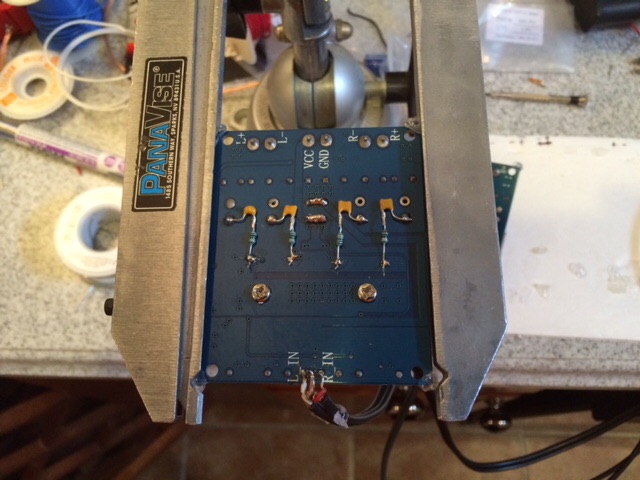
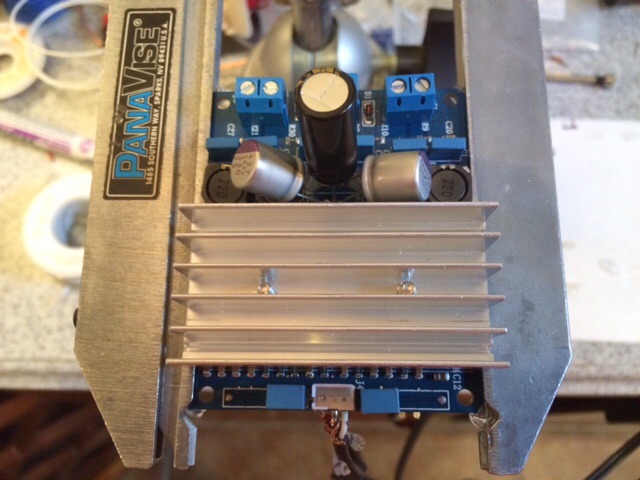
Here they are with 2x4 miniDSP.
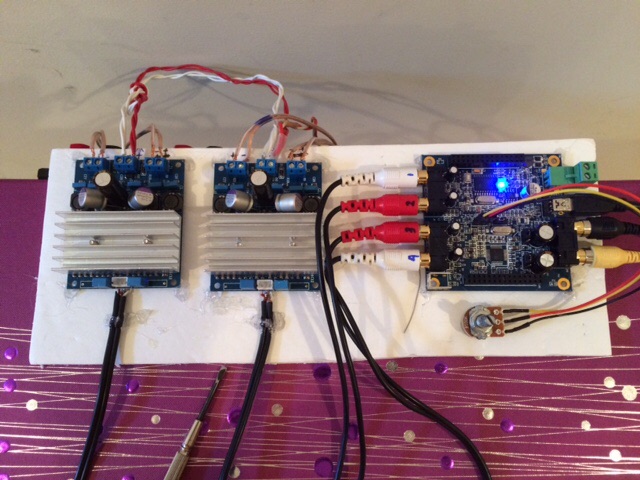
Attachments
Last edited:
Compare with article you may have read a couple times, Trevor Marshall, with 7492 you can copy something that was measured, no my-fi.
Compare with article you may have read a couple times, Trevor Marshall, with 7492 you can copy something that was measured, no my-fi.
Link?
Link?
xrk,
Hmm, may be I should give these STM chips a try too.
Try this link. Quite informative.
Trevor Marshall - Class D Audio Amplifier Design - TDA7498 Output filters
Regards,
I did not measure any perceptible distortion at the speaker vs 3116 Ybdz. Still -55dB at 1kHz and above. My cheap board has rectangular brick shaped film output caps and not xr7 ceramic. It sounds like a nice performer and perhaps up and coming competition for 3116. It has very small 22uH inductors so I wonder how much current they can handle. But they don't run hot like the YJ Blue black does. The main heatsink is warm on general though compared to 3116.
TDA7492 closeup.
I pulled the heat sink off my amp and see that it's a Feixiang and follows the STM circuit schematic pretty closely. They add a few extras like very nicely closely spaced extra bypass caps for the main power rails. The input caps have been upgraded from 470pF to 1uF EPCOS film caps. The output filters seem to be using a compromise arrangement of 22uH and 220nF and 100nF film caps. Usually this would be with 33uH inductors.
There is one inductor - the far right one that runs hot relative to others and other amp board. The external ferrite shield cage looks chipped and I wonder if this is cause. It is uncomfortably hot to touch even when idle. May have to change it. It still sounds great though.
I think it may be time to start a new 7492 thread to keep from being OT.
Btw, the 3116 thread just broke 1M views!

I pulled the heat sink off my amp and see that it's a Feixiang and follows the STM circuit schematic pretty closely. They add a few extras like very nicely closely spaced extra bypass caps for the main power rails. The input caps have been upgraded from 470pF to 1uF EPCOS film caps. The output filters seem to be using a compromise arrangement of 22uH and 220nF and 100nF film caps. Usually this would be with 33uH inductors.
There is one inductor - the far right one that runs hot relative to others and other amp board. The external ferrite shield cage looks chipped and I wonder if this is cause. It is uncomfortably hot to touch even when idle. May have to change it. It still sounds great though.
I think it may be time to start a new 7492 thread to keep from being OT.
Btw, the 3116 thread just broke 1M views!

Attachments
Last edited:
I think it may be time to start a new 7492 thread to keep from being OT
Perhaps we should. I'd like to hear more about your mods. I only have experience with the TPA3116, so seeing those Oscons in there with that bigger cap seems strange to me. Did you drill the holes in the PCB?
Perhaps we should. I'd like to hear more about your mods. I only have experience with the TPA3116, so seeing those Oscons in there with that bigger cap seems strange to me. Did you drill the holes in the PCB?
New thread here
http://www.diyaudio.com/forums/class-d/275505-tda7492-amp.html
No I did not drill new holes. 3 sets were there already. The FM is slow response supply and oscons are low ESR rapid response supply for transients.
New thread here
http://www.diyaudio.com/forums/class-d/275505-tda7492-amp.html
No I did not drill new holes. 3 sets were there already. The FM is slow response supply and oscons are low ESR rapid response supply for transients.
After listening to your speaker recorings I trust your judgement of how it sounds.
been looking at the datasheet, and not particularly keen on their W vs thd graphs at 20W.
interesting tho to see the switching frequency so low. Maybe that has something to do with heat, possibly pushing the IC very hard.
also like the layout of using the zobel/impedance levelling CR before the LC. had considered something similar on 3116 YJ board as I am using a pllxo before amps, running outputs directly to drivers. something for me to experiment with.
- Home
- Amplifiers
- Class D
- TPA3116D2 Amp
